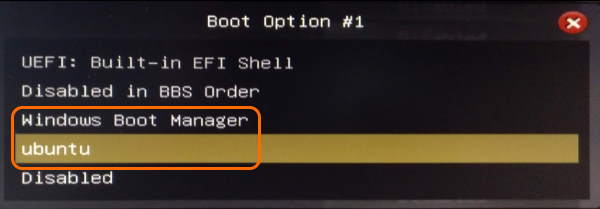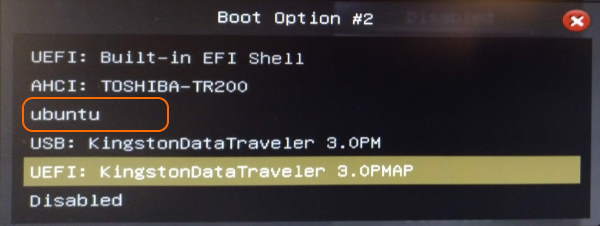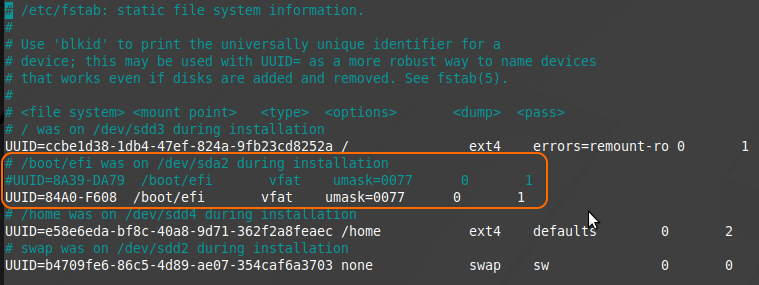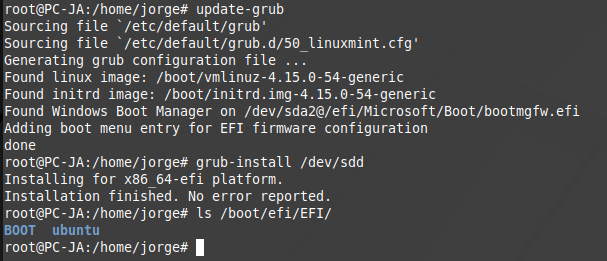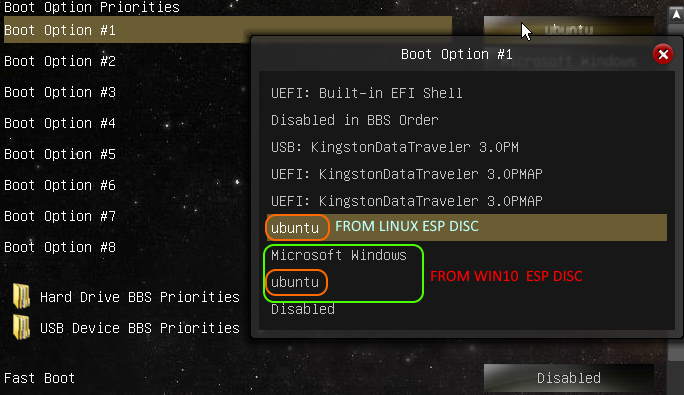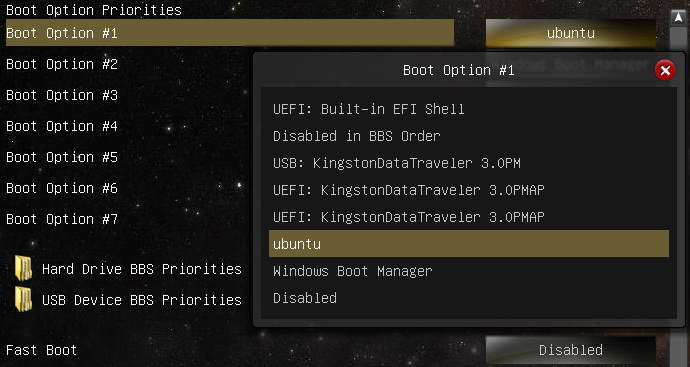Hi, Howard,
Thanks for the tip
I never had problems with GRUB because I always had the WIN10 option in GRUB, since I installed Linux Mint.
My problem is I think I need to add “something” to Linux EFI Disc for the UEFI to have the options from EFI Linux Disk and not from EFI WIN Disc when I boot.
I know this is very confused because I don’t know what i’m really looking for - This is all new for me… EFI, UEFI…
@1crazypj, can you use a flash drive and perform your update from the ‘live’ USB?
one of my first thoughts is whether or not you have fast boot (fast startup, hiberboot or whatever the proper name is) disabled. i haven’t dual booted with win10 in some time, but this suggestion (to disable fast boot) comes up on reddit fairly often when discussing win10/linux dual boot issues.
Howard,
Here is another example what happens with my system:
In this image, you can see the WIN10 EFI with 3 folders: Boot, Microsoft and ubuntu and Linux EFI only with 2 folders:Boot and ubuntu.
If I boot with WIN10 EFI options, I have Windows Boot Manager and ubuntu:
If I delete ubuntu folder from WIN10, for example, I lose the ubuntu boot option in UEFI when I boot with WIN10 EFI options:
If you boot with Linux EFI options, I only have ubuntu option to boot:
I think I need to add windows boot folder to Linux EFI but I don’t know how to do it
Cord,
yes, I have Fast Boot Disabled:
![]()
And Secure Boot is disabled too:
![]()
Howard,
I have this in GRUB related to WIN10:
BEGIN /etc/grub.d/30_os-prober
menuentry ‘Windows Boot Manager (on /dev/sda2)’ --class windows --class os $menuentry_id_option ‘osprober-efi-8A39-DA79’ {
insmod part_gpt
insmod fat
set root=‘hd0,gpt2’
if [ x$feature_platform_search_hint = xy ]; then
search --no-floppy --fs-uuid --set=root --hint-bios=hd0,gpt2 --hint-efi=hd0,gpt2 --hint-baremetal=ahci0,gpt2 8A39-DA79
else
search --no-floppy --fs-uuid --set=root 8A39-DA79
fi
chainloader /efi/Microsoft/Boot/bootmgfw.efi
}
set timeout_style=menu
if [ “${timeout}” = 0 ]; then
set timeout=10
fi
END /etc/grub.d/30_os-prober
BEGIN /etc/grub.d/30_uefi-firmware
menuentry ‘System setup’ $menuentry_id_option ‘uefi-firmware’ {
fwsetup
}
END /etc/grub.d/30_uefi-firmware
one tip i just read here is to make sure that your linux drive is listed first in the bios boot order. i don’t know that will definitely fix the issue, but seemed like it would be worth passing on.
Why? Use the update manager to do so as is instructed to do so on the official Mint home pages. When doing so it solves all the problems of upgrading. I am not even sure that you can do it just through the terminal. I stand to be corrected on this, but certainly since the start of the 18 series it is the standard way of doing things.
I know in the past peeps used to use the terminal to do many things, but now I hardly ever use it.
Windows will dominate, so yes you do need to have Linux first when dual booting, I learnt that when I was first starting out. I think this is because most laptops etc (but not all) come with it preinstalled and when you go into recovery mode, they go to Windows first. Even if you change your hdd or sdd this seems to happen, I don’t know why. So yes you are correct on this as I have found out from personal experience. Once I had changed the order of booting I was okay, but to be honest the only real solution is just to run Linux and not dual boot
Cord,
The link you mentioned describes exactly the way I Install Linux but, in my case, it fails in step J:
J) Upon reboot
After UEFI/BIOS reads the new bootloader entry that Linux has added to it, you will be presented with the grub menu with a listing of your Linux distro as well as a listing to boot Windows 10.
Kev,
Forget my Windows disc
And If I want to install two different Linux distros, one in each disc?
I need dual boot and have same problem too
the part i was wondering about was from a different answer. it was this:
then set the first boot device to linux installed HDD at the BIOS/UEFI. Otherwise, you can only boot with Win10
I know Cord.
It’s difficult for me to explain in foreign language what happens in my case.
Possibly I’m doing something wrong during installation or need to do something else but I don’t know why
I read a lot about this matter and did a lot of tests - you know me: I don’t post here and wait for an answer - but I cannot find nothing about this matter. Maybe I don’t understand how UEFI, EFI, ESP, etc., works and it’s my fault and I admit I have no knowledge at all about this matter
I’m going to do a fresh install, clean up all Linux related entries on the WIN EFI disk and post here the photos with all the steps of how I install Linux
i think you are doing a great job of explaining. i don’t know a whole lot about uefi either and your situation seems to be more complex because you have two different disks involved.
i just wanted to make sure that i was a bit more clear about what i was asking since the link i provided had a lot of different answers. turns out my laptop doesn’t even have the setting i was asking you to change or look at. i went to take a picture to make sure we were both on the same page and it just wasn’t there. my apologies for not checking before making the suggestion. perhaps that setting has gone the way of the dinosaur ![]()
i know you do a lot of work before and after posting. hopefully at some point that all pays off with a well-behaved machine.
Cord,
Thanks for the support
I think if I post photos of my step-by-step Linux installation, everyone could understand better what’s going wrong or what I’m doing wrong and help to do the correct Linux installation ![]()
i found this page that seems to have some good information on uefi/efi/bootloaders. it is aimed at linux bootloaders and boot managers, but also has some stuff about windows that might be helpful.
this part seemed relevant to your situation:
The boot loader launched by the firmware can load an OS directly (as the Windows EFI boot loader does) or it can present a menu or prompt with additional options (as most Linux EFI boot loaders do)
so it sounds like what the windows boot loader is doing (not giving you a linux option or menu) is how it is supposed to work, not that you are installing mint incorrectly.
i’m still reading some of the other pages to see if it eventually talks about dual booting on multiple drives, but wanted to share the resource ![]()
@Tech_JA I feed bad that no one has a solution for you and we (myself included) keep tossing suggestions that don’t work. Apparently, you are doing something none of us have done. ie: Windows on one disk, Linux on another.
Reading I came across this “step by step” procedures for installing dual boot for 2 different disks.
Well, I think I found the issue and it could be a bug of the Linux Mint install program.
My Linux disc is the /dev/sdd and have 4 partitions where /dev/sdd1 is the ESP.
I choose /dev/sdd1 as device for boot installation as you can see in the picture below:
After finished the installation, I reboot the PC and checked UEFI and only had ubuntu option:
I noticed that the Linux Mint install program didn’t use my selection for boot loader installation and didn’t mount the ESP of the Linux disc but mounted ESP of WIN10 disc:

I changed fstab to mount the correct ESP
NOTE: I think this is the problem. Please read the commented line added during installation:
# /boot/efi was on /dev/sda2 during installation
After umount /dev/sda2 and mount /dev/sdd1 I realized that there were no files or directories on ESP Linux disc, so I ran the following commands:
update-grub
grub-install /dev/sdd
And now I already have the correct directories on ESP Linux disc:
After another reboot, I now have 2 ubuntu entries in boot options because ESP WIN disc has an ubuntu directory:
I deleted ubuntu directory from ESP WIN10 disc and now I only have one ubuntu in UEFI boot options:
I always had the grub menu after this last Linux installation and when I first ran Windows through grub, WIN10 worked normally and after rebooting to access UEFI I noticed that the Microsoft Windows option changed its name to Windows Boot Manager
Now, the grub, Linux and WIN10 works has expected:
After these changes, I have both ESP with their directories and files:
I would like to thank all the participants in this thread for their help and motivation in solving this problem.
Thank you very much!
Jorge
Cord,
Thanks for the link
I had already read this page a few days ago
Howard,
Thanks for the link.
why do you feel bad?
You were one of the members who gave me all the support and encouraged me not to give up, with all the tips you could find.
For others, this problem may be very simple to solve, but not for me.
I didn’t know anything about it and I forgot everything I knew about Linux since I stopped using it almost 9 years ago.
And later, came Cord and ask “any more luck getting this sorted the past few days?” which that doesn’t allow us to give up eheheh
Thank you very much!
In short:
in my opinion, all the problems I had were due to a Linux Mint 19.2 installation error/bug

